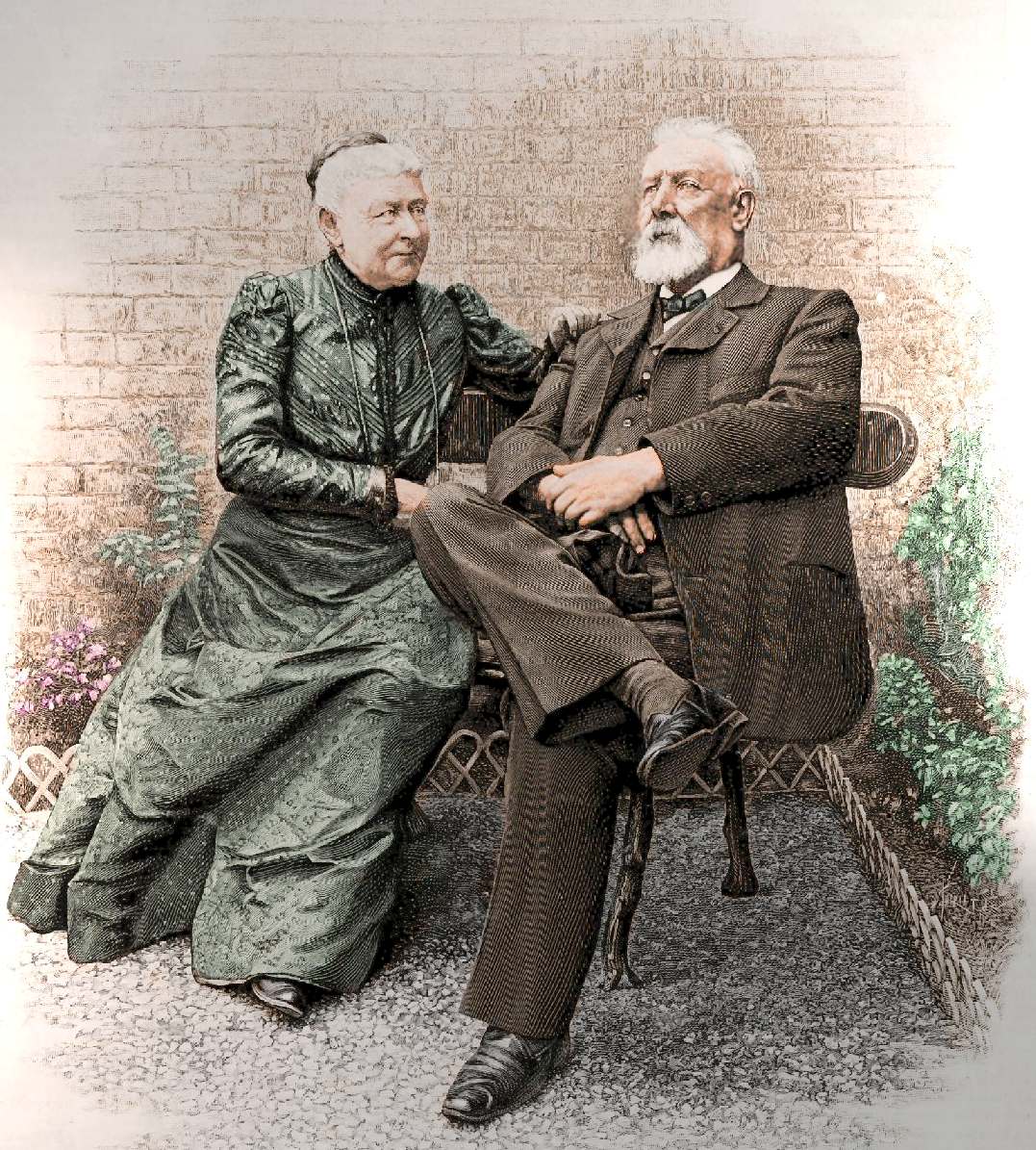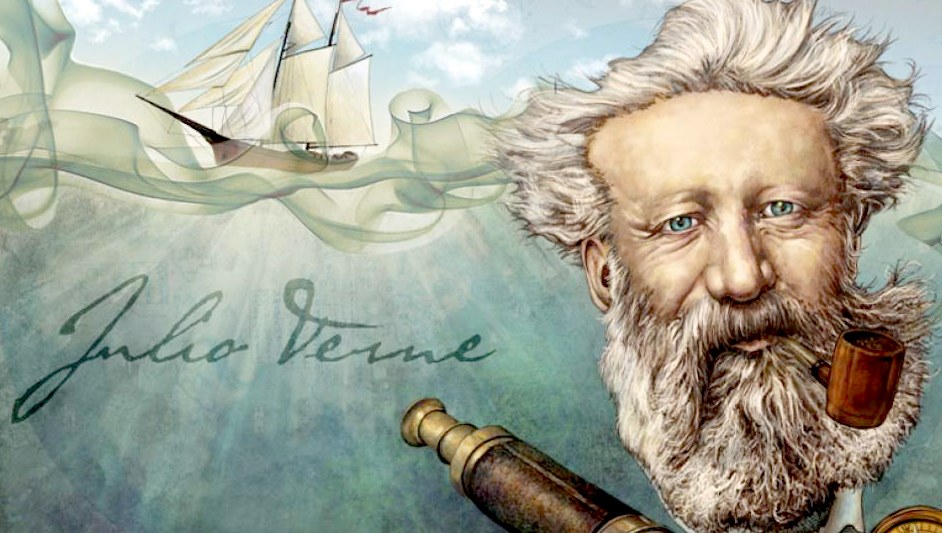|

What
a wonderful imagination the French writer had. He was also a practical
mariner, gaining much of his material from his travels, just like Herman
Melville, for his Moby
Dick. Jules Verne is best known for '20,000
Leagues Under the Sea' and Around
The World In Eighty Days. But he also authored a number of other
popular novels, that made it onto the big screen, such as 'The
Mysterious Island,' and 'Journey To The Centre Of The World.'
FAMILY
LIFE
In May 1856, Verne traveled to Amiens to be the best man at the wedding of a Nantes friend, Auguste Lelarge, to an Amiens woman named Aimée du Fraysne de Viane. Verne, invited to stay with the bride's family, took to them warmly, befriending the entire household and finding himself increasingly attracted to the bride's sister, Honorine Anne Hébée Morel (née du Fraysne de Viane), a widow aged 26 with two young children. Hoping to find a secure source of income, as well as a chance to court Morel in earnest, he jumped at her brother's offer to go into business with a broker. Verne's father was initially dubious but gave in to his son's requests for approval in November 1856. With his financial situation finally looking promising, Verne won the favor of Morel and her family, and the couple were married on 10 January 1857.
Verne plunged into his new business obligations, leaving his work at the Théâtre Lyrique and taking up a full-time job as an agent de change on the Paris Bourse, where he became the associate of the broker Fernand Eggly. Verne woke up early each morning so that he would have time to write, before going to the Bourse for the day's work; in the rest of his spare time, he continued to consort with the Onze-Sans-Femme club (all eleven of its "bachelors" had by this time gotten married). He also continued to frequent the Bibliothèque to do scientific and historical research, much of which he copied onto
note-cards for future use - a system he would continue for the rest of his life. According to the recollections of a colleague, Verne "did better in repartee than in business".
In July 1858, Verne and Aristide Hignard seized an opportunity offered by Hignard's brother: a sea voyage, at no charge, from Bordeaux to Liverpool and Scotland. The journey, Verne's first trip outside France, deeply impressed him, and upon his return to Paris he fictionalized his recollections to form the backbone of a semi-autobiographical novel, Backwards to Britain (written in the autumn and winter of 1859–1860 and not published until
1989). A second complimentary voyage in 1861 took Hignard and Verne to Stockholm, from where they traveled to Christiania and through Telemark. Verne left Hignard in Denmark to return in haste to Paris, but missed the birth on 3 August 1861 of his only biological son, Michel.
Meanwhile, Verne continued work on the idea of a "Roman de la Science", which he developed in a rough draft, inspired, according to his recollections, by his "love for maps and the great explorers of the world". It took shape as a story of travel across Africa and would eventually become his first published novel, Five Weeks in a Balloon.

THE
FATHER OF SCIENCE FICTION
Jules Verne
hit his stride as a writer after meeting publisher Pierre-Jules Hetzel, who nurtured many of the works that would comprise the author's Voyages
Extraordinaires.
In all, Verne authored more than 60 books (most notably the 54 novels comprising the Voyages
Extraordinaires), as well as dozens of plays, short stories and librettos. He conjured hundreds of memorable characters and imagined countless innovations years before their time, including the
submarine, space travel, terrestrial flight and deep-sea exploration.

CLASSIC
WORKS - Jules Verne is best known for 20,000 leagues Under the Sea and
Around the World in Eighty Days, both of which became Hollywood
classics. Jules Verne was and still remains one of the best-renowned science fiction authors. His books were decades and even centuries ahead of their time, and while the initial reception to some of his books may have been muted they have nevertheless continued to amaze many as well as influence scientific discourse and debates. He remains unparalleled when it comes to science fiction and here are some of his top books.
Jules
Verne was the author of many adventure stories:
1
Twenty Thousand Leagues Under the Sea
2 Around the World in Eighty Days
3 Journey to the Center of the Earth
4 The Mysterious Island (Extraordinary Voyages #12)
5 From the Earth to the Moon
6 Michael Strogoff (Extraordinary Voyages, #14)
7 In Search of the
Castaways; or the Children of Captain Grant (Extraordinary Voyages, #5)
8 Five Weeks in a Balloon
9
Round the Moon (Extraordinary Voyages, #7)
10 Adrift in the
Pacific: Two Years Holiday (Extraordinary Voyages, #32)
11 The Master of the World (Extraordinary Voyages, #53)
12 The Adventures of Captain Hatteras
13 Les Tribulations d'un Chinois en Chine;
The Tribulations of a Chinese in China (Extraordinary Voyages, #19)
14 The Lighthouse at the End of the World
15 Mathias Sandorf (Extraordinary Voyages, #27)
16 Off On A Comet (Extraordinary Voyages, #15)
17 Los quinientos millones de la Begún (The five hundred million of the
Begún)
18 Facing the Flag (Extraordinary Voyages, #42)
19 Un capitán de quince años (A fifteen year old captain)
20 El Testamento de un excentrico (The Testament of an eccentric)
Many
people have used the eighty day target set by Jules Verne as the
goalposts for their technology projects having been inspired by the
famous French author. We are likewise enthused.
|


